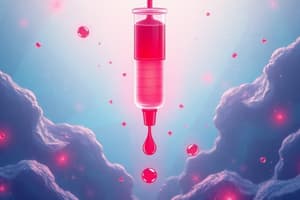Podcast
Questions and Answers
What is the normal blood glucose level range?
What is the normal blood glucose level range?
The normal blood glucose level range is 4-8 mmol/L.
Identify two common signs of hyperglycemia.
Identify two common signs of hyperglycemia.
Polyuria and Polydipsia are two common signs of hyperglycemia.
How would you educate a patient with T2DM on monitoring their blood glucose levels?
How would you educate a patient with T2DM on monitoring their blood glucose levels?
Instruct the patient to use a glucose meter and check their levels consistently, such as before breakfast and dinner.
What immediate actions should be taken for a patient with hyperglycemia?
What immediate actions should be taken for a patient with hyperglycemia?
Why is insulin administered to patients with diabetes?
Why is insulin administered to patients with diabetes?
What type of exercises would you recommend for a patient with T2DM and peripheral vascular disease?
What type of exercises would you recommend for a patient with T2DM and peripheral vascular disease?
What are ketones and why are they concerning?
What are ketones and why are they concerning?
Identify the healthcare professionals you would refer a diabetic patient to for comprehensive management.
Identify the healthcare professionals you would refer a diabetic patient to for comprehensive management.
Define hypoglycemia and its typical blood glucose range in diabetic patients.
Define hypoglycemia and its typical blood glucose range in diabetic patients.
What does DKA stand for and what patients are likely to experience it?
What does DKA stand for and what patients are likely to experience it?
What are common signs and symptoms of hypoglycemia to look for in a patient?
What are common signs and symptoms of hypoglycemia to look for in a patient?
How would you manage a patient with DKA?
How would you manage a patient with DKA?
What immediate actions should be taken for a conscious patient experiencing hypoglycemia?
What immediate actions should be taken for a conscious patient experiencing hypoglycemia?
What does HHNS stand for and what is a key feature of this condition?
What does HHNS stand for and what is a key feature of this condition?
What steps should be followed if a patient is found unconscious due to hypoglycemia?
What steps should be followed if a patient is found unconscious due to hypoglycemia?
How would you monitor a hypoglycemic patient's response to treatment?
How would you monitor a hypoglycemic patient's response to treatment?
Flashcards are hidden until you start studying
Study Notes
Blood Glucose Levels
- Normal blood glucose level range: 4-8 mmol/L
Hyperglycemia
- Common Signs and Symptoms:
- Polyphagia (increased hunger)
- Polydipsia (increased thirst)
- Polyuria (increased urination)
- Nausea and Vomiting (Diabetic Ketoacidosis - DKA)
- Slow wound healing
- Dry mouth
- Dehydration
- Blurred vision
- Focused Nursing Assessment:
- Glasgow Coma Scale (GCS)
- Blood Glucose Level (BGL)
- Ketones (if BGL > 13 mmol/L)
- Skin assessment (Peripheral neuropathy)
- Immediate Actions:
- Administer prescribed insulin
- Report to RN or NIC if unconscious
- Monitor BGL after insulin administration
Insulin
- Insulin regulates blood sugar levels
- For type 1 diabetics, it is essential as they cannot produce insulin.
- It may be necessary for type 2 diabetics when other treatments fail (oral medications, lifestyle changes).
- Insulin allows glucose from the blood to enter cells, providing energy.
- Side Effects:
- Redness and swelling at injection site
- Weight gain
- Constipation
- Hypoglycemia
Ketones
- The liver produces ketones for energy when there is a lack of glucose.
- Ketones are acidic; high levels cause rapid breathing to remove excess acid.
- Diabetic Ketoacidosis (DKA):
- Occurs when BGL > 13 mmol/L
- Symptoms: nausea, vomiting, dehydration (due to body trying to remove waste)
- DKA Management:
- Administer insulin
- Administer fluids (due to dehydration)
- Administer bicarbonate (as prescribed)
- Monitor potassium levels (fluid administration can dilute potassium)
Hyperosmolar Hyperglycemic State (HHNS)
- A dangerous state resulting from high BGL without ketones.
- Occurs gradually due to severe dehydration.
- Signs and Symptoms:
- Polyuria
- Polydipsia
- Polyphagia
- Dizziness
- Fatigue
- Coma (late stage)
- Management:
- Administer insulin
- Administer fluids
- Monitor electrolyte status
### Diabetes Management
- Patient Education for T2DM:
- Teach blood glucose monitoring using a glucose meter.
- Encourage consistent monitoring, like before breakfast and dinner.
- Suggest seated exercises like lateral raises and leg lifts (considering peripheral vascular disease).
- Encourage joining diabetes or mental health support groups.
### Patient Referrals
- Endocrinologist: Adjust medication
- Dietitian: Personalized dietary advice
- Podiatrist: Foot health
- Physical Therapist: Exercise program development
- Social Worker: Support for living alone with a dog
Hypoglycemia
- Occurs when blood glucose level is below 4-8 mmol/L.
- Can occur in diabetics taking excess insulin, during fasting, or with increased physical activity.
- Common Signs and Symptoms:
- Shakiness
- Dizziness
- Hunger
- Confusion (severe)
- Factors contributing to hypoglycemia in diabetics:
- Excess insulin
- Increased physical activity
- Malnutrition/starvation
Hypoglycemia Recognition and Management
- Recognition Signs and Symptoms:
- Physical symptoms: shakiness, paleness, dizziness
- Confusion, difficulty concentrating, hunger
- Immediate Actions:
- Follow hospital policy.
- Evaluate patient consciousness:
- If conscious and alert: Administer fast-acting carbohydrates (juice, cordial, sugar).
- If unconscious: Call Code Blue or MetCall, maintain airway, administer prescribed medication.
- Safety and Monitoring:
- Conduct assessments (vital signs, GCS).
- Monitor BGL (conscious: every 15 minutes; unconscious: every 5 minutes).
- Document BGL, treatment, and response.
Studying That Suits You
Use AI to generate personalized quizzes and flashcards to suit your learning preferences.


